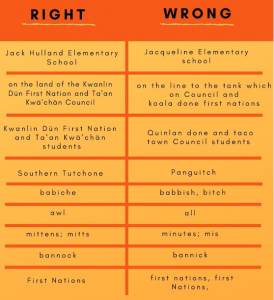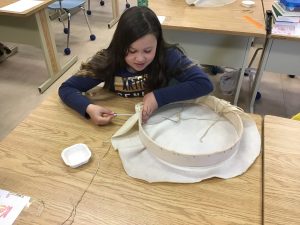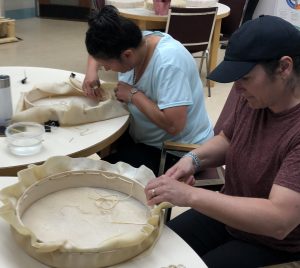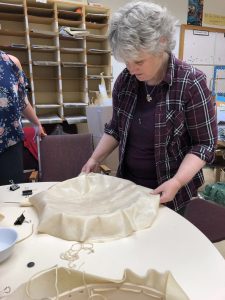For this task, I told a story about making frame drums with fellow teachers last Thursday. The drums will be given to our graduating grade seven students. I used the dictation format that our Learning Assistance teachers suggest to our classroom teachers; open a Word document and ‘fn-fn’. I’m a believer that if we ask our students to use a program or complete a task, such as creating a portfolio or self-evaluation, then we should be prepared to use the same methods to experience the process. I have also used this dictation method when I taught grade four and have first-hand knowledge about the frustrations from the teacher perspective. My unedited story below confirms the limitations:

There are many places that my oral creation is not representative of what I would have created using planned writing, and much of it deviates from proper written English. Punctuation is absent, spelling is horrific, and grammar is choppy. Although this ‘writing is made material by technology’ (Haas, 2013, p.3), I tried to create a beautiful Barbie and ended up with Frankenstein. With so many errors, it is hard to develop a groove to reading and meaning-making becomes more difficult.
The most pronounced spelling mistakes are proper nouns, followed by context or culture-specific common nouns, and what could be interpreted as my mumbling and scattered cadence.

Context-specific vocabulary was also assigned incorrect word choice, such as ‘outdoor learning traditional space’ turned into ‘ outdoor learning space station’ and to ‘attach the hide’ became to ‘live stream’. It is ironic that two traditional ideas were turned into two technological-age vocabulary words. Last time I checked, being out on the land in traditional ways is pretty far from being on the space station.
Most importantly, I was disappointed that my speech-to-text is glaring in the lack of respect that is deserved with sensitive topics. I give land acknowledgement and am talking about traditional First Nation people and objects that hold sacred and culture value. For the dictation to have mashed up words, especially in crude ways (i.e. calling ‘babiche’ – bitch), I feel that it not only distracts from the message, but offends a culture and ritual. In addition, the oral dictation lacks emotion to draw-in the reader and/or engage the audience through conversation. In planned writing, the author can proactively describe and assume questions or comments that the audience might hold and address them in their work. For example, one part left out of the story was that when kids make their drum, they are asked (as per tradition) to give it away to someone special. If this monologue story was told in writing or been given the opportunity to be presented as a back-and-forth conversation with an attentive audience, then important pieces of the story would most certainly been included. I found that without brainstorming and scripting, it was harder to formulate and make connections between beginning, middle and end, as well as remembering to include important details in order. Writing is planned, so it can be analyzed and stored forever; therefore, it is more likely to be carefully crafted.
My last point, in thinking about the drum as material. For example, watching dance or hand games, it is easy to hear the drum beat as a medium for storytelling, art and communication (just as we saw in Module Two with the tap dancing of Alexander MacDonald). In this way, the drum could also be seen as a technology.


 Drum making BY grade seven students, June 2019
Drum making BY grade seven students, June 2019


 Staff drum making FOR grade sevens during COVID-19 closure, June 2020
Staff drum making FOR grade sevens during COVID-19 closure, June 2020
Haas, C. (2013). The Technology Question. In Writing technology: Studies on the materiality of literacy. (pp. 3-23). New York, NY: Routledge.

Hi Valerie,
I really can appreciate that you try the technology that your students use. My own students are reluctant to try voice to speech technology which although not perfect would be better than not recording their ideas and thoughts. Then I read your analysis further and remembered a student who became so frustrated with voice to text technology. How do we encourage students to use this technology if it is so flawed? It seems that it needs to be more multilingual to correctly pick up and respect the languages of First Peoples. Yes, ‘writing is made material by technology’ (Haas, 2013, p.3) as you note, but it does not make an oral story telling. Oral language and written text are not interchangeable; they serve different purposes. Your story would have flowed, maybe circling back to things forgotten but it would have been expressive, correct and beautiful (more than Barbie- she is fake). I believe there is a place for carefully planned writing but also a place for oral storytelling. What do you think?
Thanks for the comments, Rebecca. I totally agree! Shaun made a good point in his post about how it made him more aware as a speaker in the future. In addition to your comments and his, I think I can see how the definition of ‘speaker’ would play a key role in that, such as considering audience, purpose, etc. For me, the ability to have a back-and-forth collaboration with questions, comments and incremental growth to dig deeper is something that this task made me realize that I value. As opposed to a monologue, soliloquy or even a closed-ended storytelling session, I think a collaborative aspect to speaking is something I value. I feel the same about f2f/sync online sessions versus async because of the time given to plan and be proactive rather than reactive.
Hi Valerie,
I loved your statement “It is ironic that two traditional ideas were turned into two technological-age vocabulary words. Last time I checked, being out on the land in traditional ways is pretty far from being on the space station.” and begin to wonder what in the coding of the program may have caused this?
Does the logic of the program just look for commonly used words in recent years more quickly? Is there a “bias” to this technology… Or is it just programmed to hear only English words and not to translate across languages or in instances of code switching yet?
Thanks for prompting interesting thoughts!
Hi Valarie!
I so agree – we need to use the technology we are asking our students to use! As a Foods Teacher I regularly ask students to put together short videos, but until starting this program in January, I really hadn’t used an of the video making platforms! It really made me think (although the students are usually so quick to pick up any technology!).
I also hadn’t put thought into the insensitivity of voice to text in terms of cultural acknowledgement and phrasing. I have felt that a bit with auto correct on my phone …
Thank you for this insight!
Meg.